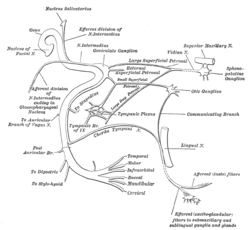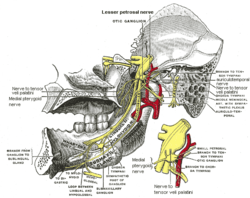Lesser petrosal nerve
| Lesser petrosal nerve | |
|---|---|
 Plan of the facial and intermediate nerves and their communication with other nerves. | |
 Mandibular division of trifacial nerve, seen from the middle line. The small figure is an enlarged view of the otic ganglion. (Small petrosal labeled at center top and bottom right.) | |
| Details | |
| Latin | nervus petrosus minor |
From | tympanic plexus |
To | otic ganglion |
| Innervates | parotid gland |
| Identifiers | |
| Dorlands /Elsevier | n_05/12566476 |
| TA | A14.2.01.149 |
| FMA | 53491 |
| Anatomical terms of neuroanatomy | |
The lesser petrosal nerve (also known as the small superficial petrosal nerve) is the visceral motor component of the glossopharyngeal nerve (CN IX), carrying parasympathetic fibers from the tympanic plexus to the parotid gland.
Structure
After arising in the tympanic plexus, lesser petrosal nerve passes from the temporal bone into the middle cranial fossa via hiatus for lesser petrosal nerve. It travels across the floor of the middle cranial fossa,[1] then exits the skull via foramen ovale to reach the infratemporal fossa. The fibres synapse in the otic ganglion, and post-ganglionic fibres then travel briefly with the auriculotemporal nerve (a branch of V3) before entering the body of the parotid gland.
Variation
The Foramen petrosum (canaliculus innominatus, foramen of Arnold, petrosal foramen) a small occasional opening in the greater wing of the sphenoid bone, between the foramen spinosum and foramen ovale, for transmission of the lesser petrosal nerve.
See also
Glossopharyngeal Nerve, Overview of visceral motor component
References
This article incorporates text in the public domain from the 20th edition of Gray's Anatomy (1918)
- ↑ Kakizawa Y. et al., "The course of the lesser petrosal nerve on the middle cranial fossa." Neurosurgery. 2007 Sep; 61(3 Suppl): 15-23. PMID 17876229
External links
- Lesser+petrosal+nerve at eMedicine Dictionary
- cranialnerves at The Anatomy Lesson by Wesley Norman (Georgetown University) (IX)
- lesson3 at The Anatomy Lesson by Wesley Norman (Georgetown University) (midearcavity) (#7)
- MedEd at Loyola grossanatomy/h_n/cn/cn1/cn9.htm
- Cranial Nerves at Yale 9-10
| ||||||||||||||||||||||||||||||||||||||||||||||||||||||||||||||||||||||||||||||||||||||||||||||||||||||||||